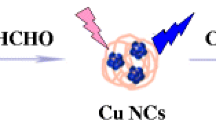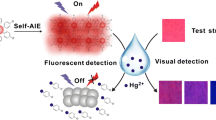Abstract
This paper describes the synthesis of fluorescent copper nanoclusters (CuNC) with a fluorescence quantum yield as high as 2.3% after modification with cysteamine. The modified CuNC are shown to be viable probes for the determination of picric acid (PA). Fluorescence drops with increasing concentration of PA which can be detected fluorometrically with a 0.14 μM limit of detection. This is much lower than required by the People’s Republic of China Surface Water Environmental Quality Standard (2.2 μM). The probe was successfully applied to the determination of PA in spiked tap water, lake water and river water.

Copper nanoclusters (CuNC) have weak fluorescence but after the modification with cysteamine, the fluorescence of CuNC is strongly enhanced. The fluorescence of such cysteamine-coated copper nanoclusters (CuNC-CA) is reduced upon the addition of picric acid (PA) through an inner filter effect (IFE).




Similar content being viewed by others
References
Steinfeld JI, Wormhoudt J (1998) Explosives detection: a challenge for physical chemistry. Annu Rev Phys Chem 49:203–232
Meaney MS, McGuffin VL (2008) Investigation of common fluorophores for the detection of nitrated explosives by fluorescence quenching. Anal Chim Acta 610:57–67
Luo TT, Li YQ, Xu YX, Zhang ST, Wang YJ, Kou XM, Xiao D (2017) Rapid synthesis of a hyperfluorescence 2-pyridone derivative as a fluorescent molecular sensor for picric acid. Sensors Actuators B Chem 253:231–238
Zhang JR, Yue YY, Luo HQ, Li NB (2016) Supersensitive and selective detection of picric acid explosive by fluorescent Ag nanoclusters. Analyst 141:1091–1097
Moghimi M, Arvand M, Javandel R, Zanjanchi MA (2005) Picrate ion determination using a potentiometric sensor immobilized in a graphite matrix. Sensors Actuators B Chem 107:296–302
Steuckart C, Berger-Prelss E, Levsen K (1994) Determination of explosives and their biodegradation products in contaminated soil and water from former ammunition plants by automated multiple development high-performance thin-layer chromatography. Anal Chem 66:2570–2577
Üzer A, Erçag E, Apak R (2004) Selective spectrophotometric determination of trinitrotoluene, trinitrophenol, dinitrophenol and mononitrophenol. Anal Chim Acta 505:83–93
Zhou HB, Yang DT, Ivleva NP, Mircescu NE, Niessner R, Haisch C (2014) SERS detection of bacteria in water by in situ coating with Ag nanoparticles. Anal Chem 86:1525–1533
Zhou HB, Yang DT, Ivleva NP, Mircescu NE, Schubert S, Niessner R, Wieser A, Haisch C (2015) Label-free in situ discrimination of live and dead bacteria by surface-enhanced Raman scattering. Anal Chem 87:6553–6561
Mei QS, Jing HR, Li Y, Yisibashaer W, Chen J, Li BN, Zhang Y (2016) Smartphone based visual and quantitative assays on upconversional paper sensor. Biosens Bioelectron 75:427–432
Yao JL, Zhang K, Zhu HJ, Ma F, Sun MT, Yu H, Sun J, Wang SH (2013) Efficient ratiometric fluorescence probe based on dual-emission quantum dots hybrid for on-site determination of copper ions. Anal Chem 85:6461–6468
Yan YH, Zhang K, Yu H, Zhu HJ, Sun MT, Hayat T, Alsaedi A, Wang SH (2017) Sensitive detection of sulfide based on the self-assembly of fluorescent silver nanoclusters on the surface of silica nanospheres. Talanta 174:387–393
Yan YH, Yu H, Zhang K, Sun MT, Zhang YJ, Wang XK, Wang SH (2016) Dual-emissive nanohybrid of carbon dots and gold nanoclusters for sensitive determination of mercuric ions. Nano Res 9:2088–2096
Yu L, Li YY, Yu H, Zhang K, Wang XW, Chen XF, Yue J, Huo TX, Ge HW, Alamry KA, Marwani HM, Wang SH (2018) A fluorescence probe for highly selective and sensitive detection of gaseous ozone based on excited-state intramolecular proton transfer mechanism. Sensors Actuators B Chem 266:717–723
Chen DM, Tian JY, Wang ZW, Liu CS, Chen M, Du M (2017) An anionic Na(i)-organic framework platform: separation of organic dyes and post-modification for highly sensitive detection of picric acid. Chem Commun 53:10668–10671
Wang BL, Mu Y, Zhang CH, Li JY (2017) Blue photoluminescent carbon nanodots prepared from zeolite as efficient sensors for picric acid detection. Sensors Actuators B Chem 253:911–917
Lin LP, Rong MC, Lu SS, Song XH, Zhong YX, Yan JW, Wang YR, Chen X (2015) A facile synthesis of highly luminescent nitrogen-doped graphene quantum dots for the detection of 2, 4, 6-trinitrophenol in aqueous solution. Nanoscale 7:1872–1878
Maity S, Shyamal M, Das D, Mazumdar P, Sahoo GP, Misra A (2017) Aggregation induced emission enhancement from antipyrine-based schiff base and its selective sensing towards picric acid. Sensors Actuators B Chem 248:223–233
Lv XJ, Qi L, Gao XY, Wang H, Huo Y, Zhang ZQ (2016) Selective detection of 2,4,6-trinitrophenol based on a fluorescent nanoscale bis(8-hydroxyquinoline) metal complex. Talanta 150:319–323
Han YX, Chen YL, Feng J, Liu JJ, Ma SD, Chen XG (2017) One-pot synthesis of fluorescent silicon nanoparticles for sensitive and selective determination of 2,4,6-Trinitrophenol in aqueous solution. Anal Chem 89:3001–3008
Deng X, Huang XM, Wu D (2015) Förster resonance-energy-transfer detection of 2, 4, 6-trinitrophenol using copper nanoclusters. Anal Bioanal Chem 407:4607–4613
Li HY, Chang JF, Hou T, Ge L, Li F (2016) A facile, sensitive, and highly specific trinitrophenol assay based on target-induced synergetic effects of acid induction and electron transfer towards DNA-templated copper nanoclusters. Talanta 160:475–480
Patel R, Bothra S, Kumar R, Crisponi G, Sahoo SK (2018) Pyridoxamine driven selective turn-off detection of picric acid using glutathione stabilized fluorescent copper nanoclusters and its applications with chemically modified cellulose strips. Biosens Bioelectron 102:196–203
Boonmee C, Promarak V, Tuntulani T, Ngeontae W (2018) Cysteamine-capped copper nanoclusters as a highly selective turn-on fluorescent assay for the detection of aluminum ions. Talanta 178:796–804
Zu FL, Yan FY, Bai ZJ, Xu JX, Wang YY, Huang YC, Zhou XG (2017) The quenching of the fluorescence of carbon dots: a review on mechanisms and applications. Microchim Acta 184:1899–1914
Su XX, Liu JB (2017) pH-guided self-assembly of copper nanoclusters with aggregation-induced emission. ACS Appl Mater Interfaces 9:3902–3910
Mei QS, Zhang K, Guan GJ, Liu BH, Wang SH, Zhang ZP (2010) Highly efficient photoluminescent graphene oxide with tunable surface properties. Chem Commun 46:7319–7321
Zhou TY, Yao QH, Zhao TT, Chen X (2015) One-pot synthesis of fluorescent DHLA-stabilized Cu nanoclusters for the determination of H2O2. Talanta 141:80–85
Wang ZG, Chen BK, Rogach AL (2017) Synthesis, optical properties and applications of light-emitting copper nanoclusters. Nanoscale Horiz 2:135–146
Wang ZG, Susha AS, Chen BK, Reckmeier C, Tomanec O, Zboril R, Zhong HZ, Rogach AL (2016) Poly (vinylpyrrolidone) supported copper nanoclusters: glutathione enhanced blue photoluminescence for application in phosphor converted light emitting devices. Nanoscale 8:7197–7202
Wang ZG, Xiong Y, Kershaw SV, Chen BK, Yang XM, Goswami N, Lai WF, Xie JP, Rogach AL (2017) In situ fabrication of flexible, thermally stable, large-area, strongly luminescent copper nanocluster/polymer composite films. Chem Mater 29:10206–10211
Yuan X, Goswami N, Mathews I, Yu Y, Xie JP (2015) Enhancing stability through ligand-shell engineering: a case study with Au25(SR)18 nanoclusters. Nano Res 8:3488–3495
Gao YQ, Qi YC, Zhao K, Wen Q, Shen JW, Qiu LY, Mou WZ (2018) An optical sensing platform for the dual channel detection of picric acid: the combination of rhodamine and metal-organic frameworks. Sensor Actuators B Chem 257:553–560
Xu YQ, Li BH, Li WW, Zhao J, Sun SG, Pang Y (2013) “ICT-not-quenching” near infrared ratiometric fluorescent detection of picric acid in aqueous media. Chem Commun 49:4764–4766
Zhang F, Zhang GW, Yao H, Wang Y, Chu TS, Yang YY (2017) A europium (III) based nano-flake MOF film for efficient fluorescent sensing of picric acid. Microchim Acta 184:1207–1213
Acknowledgements
This work was supported by the National Natural Science Foundation of China (81773684, 21505053, and 21675158), Guangdong Natural Science Funds for Distinguished Young Scholars (2018B030306033), Pearl River S&T Nova Program of Guangzhou (201806010060), Science and Technology Planning Project of Guangdong Province, China (2016A030310089), Medical Scientific Research Foundation of Guangdong Province of China (A2018133), the Fundamental Research Funds for the Central Universities (21618407), and the Basic Research Project of Knowledge Innovation Program of Shenzhen City (JCYJ20160229165250876).
Author information
Authors and Affiliations
Corresponding authors
Ethics declarations
The author(s) declare that they have no competing interests.
Electronic supplementary material
ESM 1
(DOCX 701 kb)
Rights and permissions
About this article
Cite this article
Bao, Z., Zhang, K., Jian, J. et al. Strongly fluorescent cysteamine-coated copper nanoclusters as a fluorescent probe for determination of picric acid. Microchim Acta 185, 507 (2018). https://doi.org/10.1007/s00604-018-3049-2
Received:
Accepted:
Published:
DOI: https://doi.org/10.1007/s00604-018-3049-2




